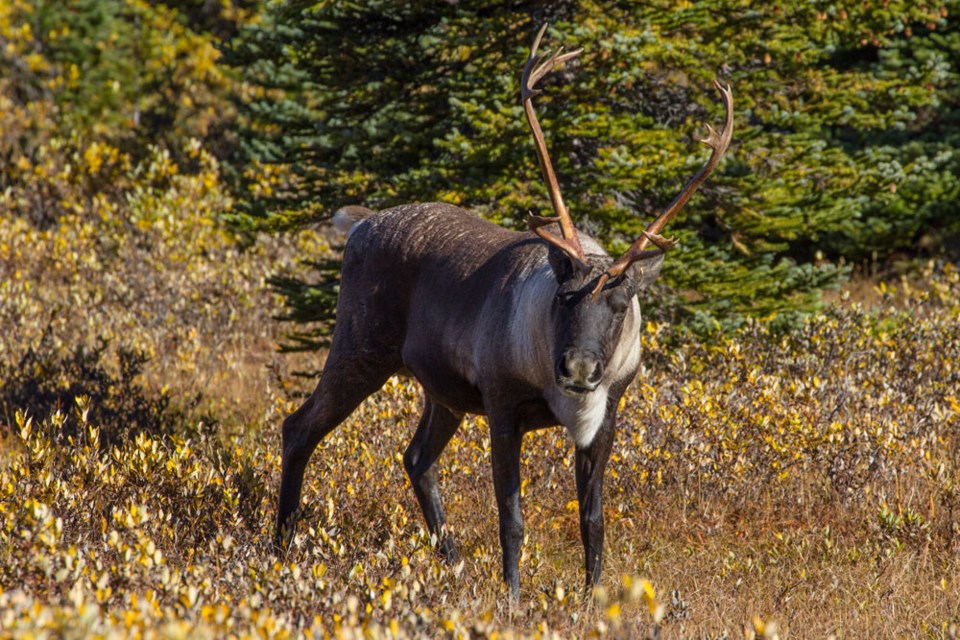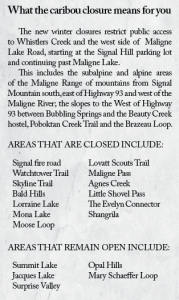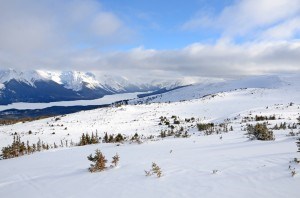
On Dec. 22 Parks Canada announced that it was restricting winter access to the Maligne Valley until Feb. 28, and Whistler Creek until Feb. 15.
The delayed winter access restricts the public from Whistlers Creek and the west side of Maligne Lake Road.
This includes the subalpine and alpine areas of the Maligne Range from Signal Mountain south, east of Highway 93 and west of the Maligne River; the slopes to the West of Highway 93 between Bubbling Springs and the Beauty Creek hostel, Poboktan Creek Trail and the Brazeau Loop
The closures are part of Parks’ intensified caribou conservation measures, after the Species at Risk Act listed Jasper’s Southern Mountain Caribou as endangered.
When Jasper’s caribou were last counted, only 41 remained: five in the Maligne herd, six in the Brazeau and 30 in the Tonquin.
Parks was legally required to ensure the caribou’s habitat was protected by Nov. 28, and until the Dec. 22 announcement many Jasperites eagerly awaited any information from the organization.
This week, the Fitzhugh has taken an in-depth look at the issue, providing reactions from environmental advocates, a prominent winter user, and perspective from Parks’ acting Field Unit Superintendent, Alan Fehr.
Closures and caribou conservation
Supt. Alan Fehr talks deadlines and rationale
 Protecting the ecological integrity of the park and connecting Canadians to nature: it was those two objectives that helped guide Parks Canada as it made the decision to add Maligne Valley and Whistlers Creek to its list of winter closures this year.
Protecting the ecological integrity of the park and connecting Canadians to nature: it was those two objectives that helped guide Parks Canada as it made the decision to add Maligne Valley and Whistlers Creek to its list of winter closures this year.
According to Alan Fehr, the acting superintendent for Jasper National Park, the closures, as well as the park’s new winter recreation opportunities, will help protect JNP’s endangered Southern Mountain Caribou, while still allowing people to experience Jasper’s wilderness.
Keeping people out of critical caribou habitat is an important part of ensuring the struggling herds’ survival, but since the Maligne Valley is the go-to destination for many winter recreationalists, Parks aimed to provide alternative options to keep people engaged.
“We’re always trying to ensure that we’re both doing the protecting as well as engaging people,” Fehr said.
He said he is pleased with the new caribou habitat protection measures, and excited about the new winter offers that were announced in conjunction with them.
Jasperites, however, are largely unhappy with the decision, and after it was announced Dec. 22, many were quick to criticize Parks’ handling of the announcement.
One common criticism is Parks’ timing. Jasperites expected to hear something by Nov. 28—a deadline that stems from Jasper’s caribou being added to the list of endangered species under the Species at Risk Act (SARA)—but on that day, nothing was announced.
“I think maybe there was a bit of a misunderstanding of what was going to happen on Nov. 28,” said Fehr.
“The Nov. 28 date is an important date because it’s on that date that the prohibition [stemming from the Species at Risk Act] came into effect. But regulatory changes happen in all jurisdictions on a regular basis,” he said.
“The thing is, within Jasper we’ve been working on caribou for 10, 15 years. So there’s been a whole series of steps taken. So Nov. 28 is an important date, but for Parks Canada, it’s just one of a series of measures that we’re going to take.”
Fehr also dismissed the idea that the announcement was purposefully made just before the Christmas holiday.
“We needed time, and I think to be fair, [we announced the closures] only three weeks after the Nov. 28 deadline. I’m not really sure what the general public’s expectation is, but I think given our track record of working on these issues [the timing of the announcement is] just strictly coincidence.
“The messages that I’m giving you today are no different from the messages I would give you several weeks ago. There are processes that we need to work through internally, and we want to make sure we work through them properly so that we can give you the right information.”

However, while Parks was going through those internal processes, skiers flocked to the Maligne Valley.
Tracks left in the snow by humans allow wolves to access the valley much easier, posing significant risk to the caribou. Winter closures are supposed to keep those tracks from forming, but winter recreationalists were given weeks of access, creating a network of such tracks in the process. When the Jasper Environmental Association spoke out against the closures, calling them “too little too late,” it pointed to this very fact as evidence.
Fehr wouldn’t say if he believed those criticism were legitimate, but did express concern that the valley was being used throughout December.
“Obviously ... we are concerned with facilitating predator access in alpine areas, that’s why we’ve taken the measures. So, are we concerned that there are some ski tracks up there? To a certain extent, yes.
“But the area wasn’t signed, we hadn’t made a large public announcement yet, so people were taking advantage of the opportunity to ski and I understand that. It’s a wonderful place to go, and it’s a wonderful place to ski, but in the long run we do hope that these measures will do a lot to protect the caribou population.”
If environmental advocates are unhappy with Parks’ handling of the decision, winter recreationalists are largely incensed.
Most agree it’s vital to protect caribou, but they are angry with what they feel is a lack of respect from Parks. They feel like Parks is pandering to visitors from outside the park, and not taking valuable advice and help from the people who know backcountry recreation best.
They’re also insulted by the new winter offers Parks is toting (backcountry user Loni Klettl called it a “list of menial, pathetic things”). The Maligne Valley has prime winter backcountry skiing, and Parks’ alternatives (10 kilometres of fat biking trails on Pyramid Bench, new snowshoe routes and better signage and trail reports) do almost nothing to fill that void.
Fehr pointed out that Parks spent months before it released its decision, engaging people—including local backcountry users—and that it will continue to do so. He said “the future is bright” for winter recreation in Jasper, and that Parks will continue to work to make it better.
While park users continue to discuss Parks’ decision, the fate of Jasper’s caribou remains uncertain.
Fehr was unable to give any new information on Parks’ captive breeding program, the future of which was cast into doubt when the Calgary Zoo backed out late last year due to funding concerns.
He did, however, point to the list of significant critical habitat protection measures that are already in place in Jasper, including monitoring and management activities to reduce predation risk to caribou; maintenance and protection of old-growth habitat; consideration of critical habitat protection in fire and vegetation management plans; and reduced speed zones on roads through critical habitat.
Fehr said Parks will continue to closely monitor caribou populations, and he remains pleased with the steps Parks has taken to protect the iconic species.
“I think we’ve taken some real sound, positive steps to protect the caribou, and I think they speak for themselves,” he said.
Trevor Nichols
[email protected]
For more on Parks Canada's recent decision to delay winter access to the Maligne and Whistlers valleys, check out our story on how it affects the Maligne Ski Club and the season for Shangrila Cabin.
Get an inside view of how backcountry users are feeling by reading Loni Klettl's column: A large black fly on the wall, or get some insight into what local environmentalists think of Parks' decision by reading Jill Seaton's column: History of caribou conservation.
